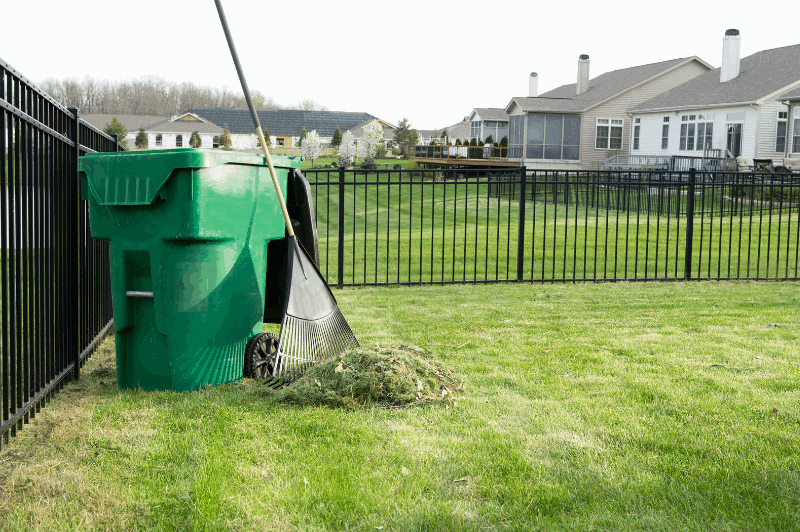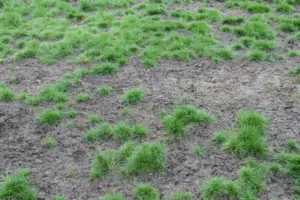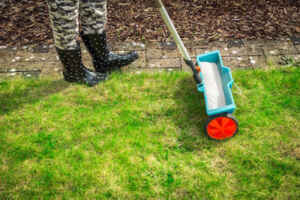Why Your Lawn Has Fungus
It’s a cool summer morning and you want to enjoy your cup of coffee and newspaper on the front porch. You do spend a lot of effort on your lawn so why not enjoy the fruits of your labor, right? Wait, is that a discolored patch of grass? There’s a really good chance that discolored spot on the lawn is caused by fungus. Catching it sooner rather than later is key to stopping fungus spread.
Why does your lawn have fungus? Your lawn may have fungus due to improper mowing, overwatering, over-fertilizing, using the wrong type of fertilizer, or simply due to weather that is conducive for the growth of fungus. Before attempting to treat fungus, it’s important to determine the type of fungus you have. Otherwise, you run the risk of damaging your lawn.
Now that you’re familiar with some of the causes of lawn fungus, let’s examine the subject in more depth so that you can find the best solution for getting rid of your lawn’s fungus.
How to Identify Lawn Fungus In Your Yard
It’s important to know what type of grass you have. Once you know that, it’s easier to narrow down the types of lawn fungal disease your yard is susceptible to.
There are many different causes and symptoms of fungus in your yard, but to treat it properly you must first figure out which one you’re dealing with! Here are a few of the most common culprits.
Identifying Brown Patch Lawn Fungus
Brown patch comes around in the summertime- it loves the heat! Active growth of brown patch occurs when temperatures reach 80 F-85 F and humidity is high. Once brown patch fungus starts, it spreads fast!
This is considered the most damaging of all turfgrass disease. Sometimes preventing brown patch is out of the homeowners’ control; just because humidity levels and air levels contribute a big part of the growth.
You can help prevent the grown by aerating and dethatching the lawn every year. The improved air circulation caused by this will reduce the humidity that causes brown patch. When appropriate, you can also apply a fungicide to your lawn to treat this type of lawn fungus. For best results, treat as soon as you see the first symptom!
Identifying Dollar Spot Lawn Fungus
Dollar spot is not picky! It will infect a large variety of different grasses and it develops into small distinct circles (about the size of a silver dollar). You’ll start to see dollar spots when temperatures are between 70 F and 90 F degrees.
A few factors that contribute to the development of this disease include low nitrogen fertility, low soil moisture, too much thatch on the lawn, and mowing the lawn too short during very hot weather. To steer clear of dollar spot on your lawn it is important to saturate your lawn regularly and to also avoid late afternoon or evening watering.
This allows your grass to properly dry out! Another thing to remember is to use the proper combination of fertilizers- this should correct the low nitrogen content in the soil.
\Identifying Gray Snow Mold Lawn Fungus
You may think that the blanket of snow on your lawn looks really pretty until you see the damage it can do. Gray snow mold primarily affects grass during cooler times of the year. Like when it snows!
Snow mold happens when you receive a deep snowfall before the grass has completely frozen over. A combination of the weight snow brings on, wintertime moisture, and the cover from leaves is what brings snow mold about! The best way to beat snow mold is prevention.
During the fall, before the first snowfall, you should apply a preventative application of lawn fungicide. If you catch it too late and you’ve tried everything you can to prevent snow mold, the damaged areas can be repaired using a patching product once weather permits.
Identifying Pythium Blight Lawn Fungus
This type of fungus often grows in lines following paths where water drainage occurs. It’s transported by water, wind, and mowing the lawn. Be sure to keep your lawn well drained and ventilated to ensure enough air is getting to the roots to prevent Pythium from starting and from spreading.
Identifying Red Thread Lawn Fungus
Are you seeing dying patches of grass with red or pink fibers in them? This is the telltale sign of red thread. Red thread is most common in cooler weather, temperatures between 68 F and 75 F. This won’t kill your grass since it infects the thatch and soil, not the crown or roots.
How to Prevent Fungus From Growing In Your Yard
Sometimes even just a simple change in your lawn care routine can prevent grass fungus from growing in your lawn. Here are a few lawn care best practices that can help you prevent fungus growth:
- Mowing: be sure your blades stay sharp and you are cutting your lawn to the proper height. Dull blades can actually tear the grass rather than cut them. Frayed blades are more susceptible to developing a disease as opposed to clean cuts. Also, it is very important to wash the underside of the mower after you use it to prevent any spread of any possible fungus.
- Watering: Water early in the morning so the blades of grass can dry all day long. Remember, the quicker the grass dries, the less chance fungus will develop. Another important watering tip is to water your grass deeply and less often. This allows water to absorb properly.
- Fertilizing: To choose the correct fertilizer for your lawn you need to know what type of grass and soil you have. Many people make the wrong choice in fertilizer and that’s when fungus starts to grow. Once you find the correct type; apply it exactly as directed.
- Aerate: Aeration perforates the soil with small holes that allows water, air, and nutrients to penetrate the roots. Aerate your lawn every one to two years so your soil can breathe.
Why Does My Lawn Have Fungus And Not My Neighbors?
You feel like you and your neighbor are doing all the same basic lawn maintenance; however, his lawn looks so much better than yours. Why is that? All lawns can be susceptible to fungus growth, but some more than others.
Your soil condition and watering patterns play a huge role in this. The property right next door to you may have a totally different soil composition, different sun exposure, or maybe even different grass. There are so many variables, that’s why it’s important to be knowledgeable about your lawn!
Can Pets Cause Brown Spots In My Lawn?
The short answer is yes! Sometimes our sweet little dogs and cats can wreak havoc on our lawn without us even knowing. Most dogs have a very high concentration of nitrogen in their urine which oftentimes causes brown spots.
This isn’t necessarily a fungus growing in your yard- so it’s important to identify the issue since this it will be treated differently. You can find more information here on preventing and treating brown spots caused by dog urine.
Can Bagging My Clippings Prevent Lawn Fungus?
Yes! If you do have fungus on your lawn, mulching will shoot the fungus back onto your lawn. However, bagging your clippings will remove and contain it.
Can I Call A Professional To Get Rid of Lawn Fungus?
We all love to figure things out on our own, but calling a professional could be the answer when things get too sticky! Lawn care professionals within your area will have the best advice on how to address fungus in your yard.
In addition to providing information on lawn care, they can also more easily and quickly diagnose the spots. Testing your soil is very important to know what type of fertilizer is healthiest for your yard- a professional can help with that too!
Lawn fungus may try to get in your way of having a beautiful lawn, but don’t let it! There are many different types of fungus and many varying reasons fungus may appear on your lawn.
Sometimes it can be frustrating to diagnose and even more frustrating to actually treat. Be proactive and try these tips and tricks to help identify and treat your lawn, or maybe calling a professional is the best way to go in your case. A lush, green lawn is within your reach!



